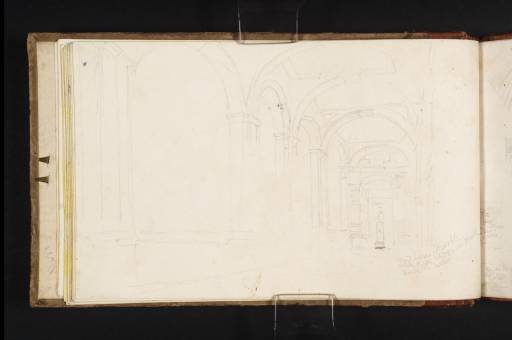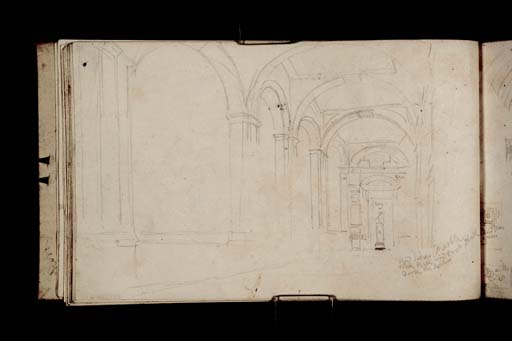Joseph Mallord William Turner Sketch of the Perspective of Raphael's Loggia in the Vatican: Study for 'Rome from the Vatican' 1819
Image 1 of 2
Joseph Mallord William Turner,
Sketch of the Perspective of Raphael's Loggia in the Vatican: Study for 'Rome from the Vatican'
1819
Joseph Mallord William Turner 1775–1851
Folio 13 Verso:
Sketch of the Perspective of Raphael’s Loggia in the Vatican: Study for ‘Rome from the Vatican’ 1819
D14955
Turner Bequest CLXXIX 13 a
Turner Bequest CLXXIX 13 a
Pencil on white wove paper, 112 x 186 mm
Inscribed by the artist in pencil ‘[...]’ within sketch top right of pediment at end of corridor. Also ‘Grey’ centre of drawing and ‘Red [?Siena] Marble | White Base and small plinth | Dark the Lower’ bottom right
Inscribed by the artist in pencil ‘[...]’ within sketch top right of pediment at end of corridor. Also ‘Grey’ centre of drawing and ‘Red [?Siena] Marble | White Base and small plinth | Dark the Lower’ bottom right
Accepted by the nation as part of the Turner Bequest 1856
Exhibition history
1974
Turner 1775–1851, Royal Academy, London, November 1974–March 1975 (215, as ‘View along One of the Loggie of Raphael in the Vatican’).
1992
Turner as Professor: The Artist and Linear Perspective, Tate Gallery, London, October 1992–January 1993 (113, reproduced).
References
1909
A.J. Finberg, A Complete Inventory of the Drawings of the Turner Bequest, London 1909, vol.I, p.527 as ‘Raphael’s Logge, Vatican’.
1965
Jerrold Ziff, ‘Copies of Claude’s Paintings in the Sketch Books of J.M.W. Turner, Gazette des beaux-arts, vol.65, January 1965, pp.56, 64 note 24.
1974
Martin Butlin, Andrew Wilton and John Gage, Turner 1775–1851, exhibition catalogue, Royal Academy, London 1974, no.215, pp.88, 92 under no.236, as ‘View along One of the Loggie of Raphael in the Vatican’.
1979
Andrew Wilton, The Life and Work of J.M.W. Turner, Fribourg 1979, p.147.
1982
Evelyn Joll and Martin Butlin, L’opera completa di Turner 1793–1829, Classici dell’arte, Milan 1982, p.107 under no.228.
1984
Martin Butlin and Evelyn Joll, The Paintings of J.M.W. Turner, revised ed., New Haven and London 1984, p.137 under no.228.
1984
Cecilia Powell, ‘Turner on Classic Ground: His Visits to Central and Southern Italy and Related Paintings and Drawings’, unpublished Ph.D thesis, Courtauld Institute of Art, University of London 1984, pp.149, 151 note 2, 235–6, reproduced pl.159, as ‘Interior of the Vatican loggia’.
1987
Robert E. McVaugh, ‘Turner and Rome, Raphael and the Fornarina’, Studies in Romanticism, no.26, Autumn 1987, p.371.
1987
Cecilia Powell, Turner in the South: Rome, Naples, Florence, New Haven and London 1987, pp.65 note 1, 113, 116, 117, reproduced pl.124, p.115, as ‘The structure of the Vatican loggia’.
1995
Cecilia Powell, ‘Turner’s Sketches: Purpose and Practice’, in Joyce H. Townsend (ed.), Turner’s Painting Techniques: In Context: 1995, London 1995, p.59.
1998
James Hamilton, Turner and the Scientists, exhibition catalogue, Tate Gallery, London 1998, p.68.
2001
Andrew Wilton, Inge Bodesohn-Vogel and Helena Robinson, William Turner: Licht und Farbe, exhibition catalogue, Museum Folkwang, Essen 2001, p.320 under no.95.
1997
James Hamilton, Turner: A Life, London 1997, p.205 note 1.
2009
Ian Warrell, ‘Painters Painted: The Cult of the Artist’, in David Solkin (ed.), Turner and the Masters, exhibition catalogue, Tate Britain, London 2009, p.229 note 1 under no.63.
2010
David Solkin and Guillaume Faroult (eds.), Turner et ses peintres, exhibition catalogue, Galeries nationales, Grand Palais, Paris 2010, pp.196, 262 note 12.
2011
Nicola Moorby, ‘Turner’s Sketches for “Rome from the Vatican”: Some Recent Discoveries’, Turner Society News, no.115, Spring 2011, pp.5, 6 as fig.4 ‘Diagram based upon “Perspective Study of the First Three Bays of the Vatican Loggia” ’, 10 notes 16 and 21.
One of the most significant series of studies dating from Turner’s 1819 trip to Rome was the sequence of on-the-spot pencil sketches relating to the Loggia of Raphael, a colonnaded porch on the second floor of the Vatican’s Apostolic Palace, decorated by Raphael (1483–1520) and his studio. The sixteenth-century loggia, which looks out over the Cortile San Damaso and St Peter’s Square, is approximately 65 metres long and 4 metres wide (215 by 13 feet) and comprised of thirteen bays. Turner made a closely detailed visual record of the room, particularly concentrating on the southern end of the interior and the decoration of the first three bays and window arches, see folios 13 verso–21 (D14955–D14965). From these drawings evolved the artist’s first exhibited oil painting following his Italian tour, the vast canvas Rome from the Vatican. Raffaelle Accompanied by La Fornarina, Preparing his Pictures for the Decoration of the Loggia 1820 (Tate, N00503).1 It has been widely suggested that Turner thought of the idea for the picture whilst he himself was actually sketching there.2 However, the precise nature of these studies, focusing almost exclusively on the first three bays of the loggia, strongly suggests that in fact the artist had already conceived the theme before commencing his sketching campaign and was specifically gathering material with the concept already well advanced in his mind. Virtually every element recorded within his drawings was employed within the composition of the finished painting, and there are no sketches extraneous to this purpose.
This page represents a study of the receding perspective of the first three bays of the loggia, looking towards the southern end with the inside wall on the right and the arched windows on the left. As Cecilia Powell first identified, Turner’s viewpoint must have been standing right up against the inside wall at the end of the fourth bay.3 Positioned at the far end of the room is a plinth containing a portrait bust of Raphael by Alessandro d’Este (1787–1826), the son of the current Director of the Vatican Museums.4 The drawing provides the main compositional basis for the right-hand side of Rome from the Vatican, although in the finished version there are three, not four, bays visible, and the plinth stands empty in favour of the figure of Raphael himself in the foreground.
Further studies related to the evolution of Rome from the Vatican can be found on folios 21 verso and 24–26 (D14966 and D14969–D14972), as well as an elaborate compositional drawing in pen and ink in the Rome C. Studies sketchbook (Tate D16368; Turner Bequest CLXXXIX 41). Turner also made two close-up studies of the bust of Raphael, see folio 25 (D14969).
Nicola Moorby
January 2010
Martin Butlin and Evelyn Joll, The Paintings of J.M.W. Turner, revised ed., New Haven and London 1984, no.228.
See Powell 1987, pp.62 and 116–7, and Hamilton et al. 2009, p.53. Hamilton, for example, has described the studies as ‘far more detailed than [Turner] would reasonably need if he were not sympathetic to, and even complicit in, a complete copying of them’ and has stated that the artist only ‘used a fraction’ of them.
How to cite
Nicola Moorby, ‘Sketch of the Perspective of Raphael’s Loggia in the Vatican: Study for ‘Rome from the Vatican’ 1819 by Joseph Mallord William Turner’, catalogue entry, January 2010, in David Blayney Brown (ed.), J.M.W. Turner: Sketchbooks, Drawings and Watercolours, Tate Research Publication, December 2012, https://www


